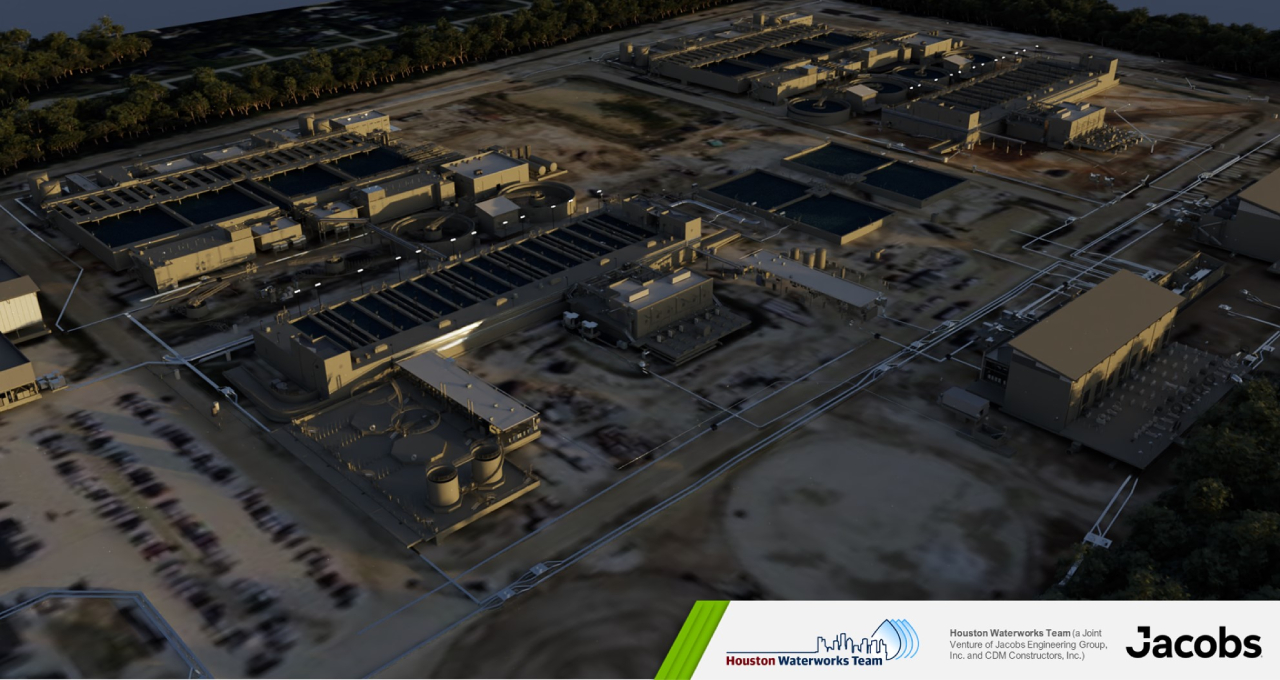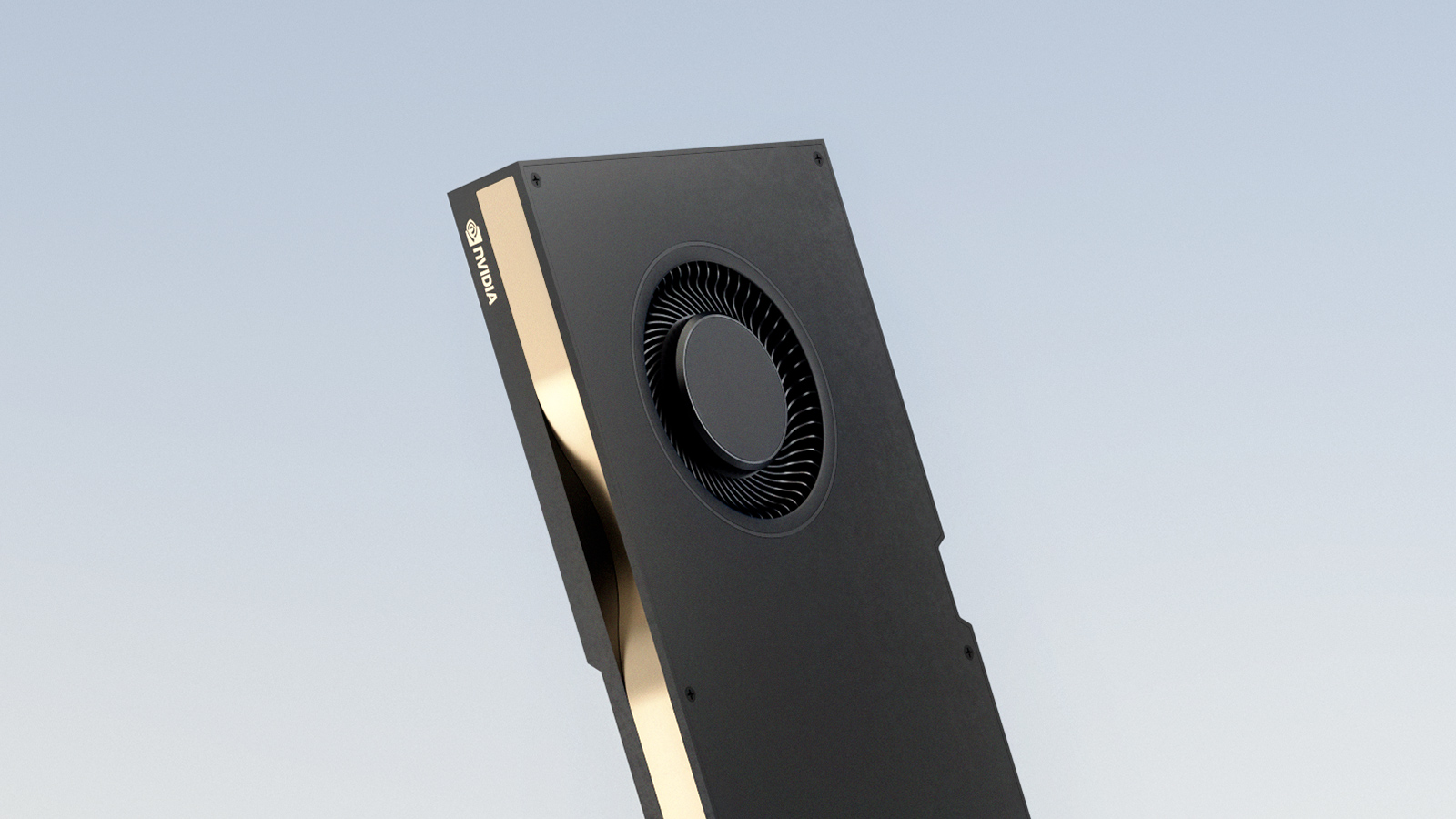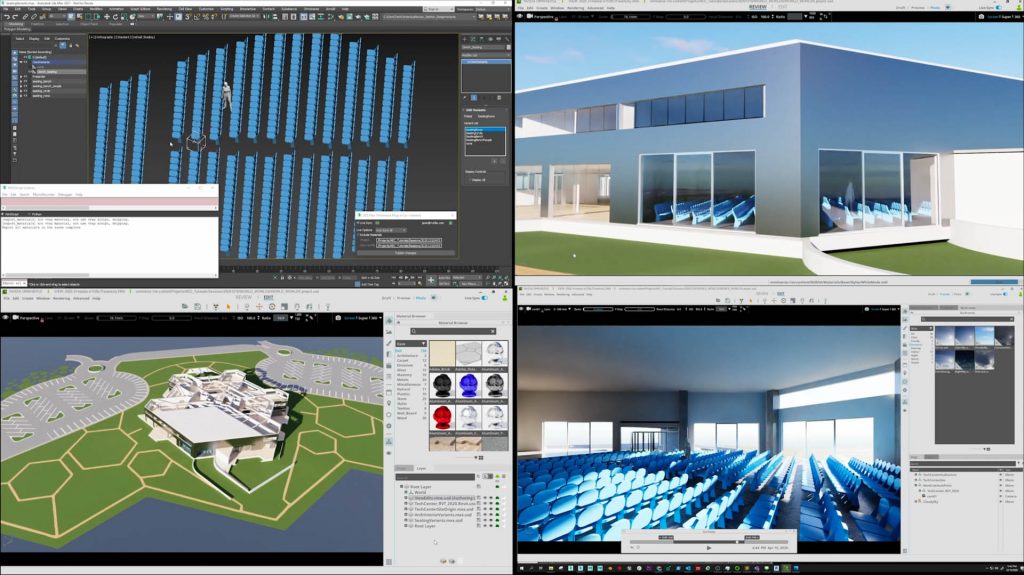Foster + Partners, KPF and Wood Bagot among early adopters of viz-focused real time collaboration platform + Bentley Systems to use Omniverse Enterprise to visualise digital twins. By Greg Corke and Martyn Day
Nvidia Omniverse, which we first covered in this in-depth article last year, is now close to a commercial release. Nvidia Omniverse Enterprise, officially announced today, will be available this summer.
The viz-focused platform, which can harness the power of Nvidia RTX real-time tracing technology and Nvidia PhysX real-time physics engine, enables global 3D design teams working across multiple CAD, BIM and viz tools to collaborate in real time in a shared virtual space. This can be with an RTX-accelerated desktop or mobile workstation, with a cloud workstation accessed via a PC, laptop or tablet, or through a VR headset streamed using Nvidia CloudXR.
“Omniverse lets us create and simulate shared virtual 3D worlds that obey the laws of physics,” says Jensen Huang, founder and CEO of Nvidia. “Once connected, designers doing modelling, layout, shading, animation, lighting, special effects or rendering can collaborate to create a scene.”
Rather than exchanging and iterating on massive files, designers, viz artists and reviewers can work simultaneously in their application of choice. Any changes made in one application instantly appear in others. This is made possible by Pixar’s USD (Universal Scene Description), an open framework for the interchange of 3D computer graphics data, specifically focused on collaboration.
Omniverse pricing will be very disappointing for some AEC Magazine readers who really love the concept of the technology and what it could bring to the veritable ‘Tower of Babel’ of AEC formats that our industry is hampered by.
“You can think of it as the HTML of 3D,” explains Richard Kerris, Industry GM for M&E at Nvidia. “It unifies how a scene is described from the models, the scene, the lighting, the shadows, the effects etc.”
As the name suggests, Nvidia Omniverse Enterprise looks to be focused on large, global firms. For workgroups of about 25 people, prices start at $1,800 per user, per annum, plus $25,000 for the Omniverse Nucleus server, which forms the backbone to the collaborative platform.
For 500 people and above the price of Nucleus Server goes up to $250,000. All prices include Nvidia’s Enterprise support services.
For small firms of five to ten users, Kerris told AEC Magazine that Nvidia will “work with the market, listen to the market.” He also added that Omniverse will be available as a free tool for individuals, which will include the platform, and some of the basic functionality.
Omniverse Enterprise technology
Omniverse Nucleus server manages the database and maintains the live sync between connected applications. It can reside on a workstation, on a server or in the cloud.
“You can think of Nucleus as the data traffic cop,” explains Kerris. “It’s going to communicate only the deltas of things that are changing, because everyone else is on the common base platform.”
Omniverse Connectors, which are application plug-ins, are needed to sync to the Omniverse Nucleus server. In the AEC sector, Omniverse Connectors are currently available for Autodesk Revit, Rhino, SketchUp, Archicad, blender, 3ds max, CityEngine, and Unreal Engine.
Bentley Systems is also integrating its iTwin platform with Nvidia Omniverse to provide a graphics pipeline for infrastructure digital twins (more on this later). Omniverse can also support point clouds.
Nvidia Omniverse Enterprise also includes two end-user applications: Nvidia Omniverse Create, which is designed to accelerate scene composition and allows users in real time to interactively assemble, light, simulate, and render scenes; and Nvidia Omniverse View, which enables users to collaboratively build, modify, and enhance a scene with physically accurate Nvidia MDL materials.

Nvidia RTX Virtual Workstation (vWS) software, which is also part of the platform, gives collaborators the freedom to run their graphics-intensive 3D applications from anywhere and on low powered devices, including standard office laptops that don’t have powerful GPUs.
Of course, Omniverse Enterprise is tested and optimised to run on Nvidia RTX laptops and desktops, and Nvidia-certified systems on the Nvidia EGX platform. Asus, BOXX, Cisco, Dell, HP, Lenovo and Supermicro have all announced support.
Nvidia has several large AEC firms already using the technology. This includes Kohn Pedersen Fox (read this AEC Magazine interview with Cobus Bothma, director of applied research at KPF), Woods Bagot and Foster + Partners.
Foster + Partners is implementing Omniverse to enable ‘seamless collaborative design to visualisation capabilities’ to teams spread across 14 countries.
“Omniverse is a revolutionary platform that has allowed our designers to collaborate and visualize multiple design changes to a scene simultaneously while working on their software of choice,” said Martha Tsigkari, partner with the Applied Research and Development Group at Foster + Partners.
“As we can review design options in parallel, we have much more time for creative design and visualisation. Integration of futuristic technologies such as machine learning will bring more opportunities to assist the creative process in the future.”
The practice will be delivering an Omniverse online workshop at this year’s Nvidia GTC entitled ‘Collaboration matters: An end-to-end workflow for the AEC industry’. A team of designers, developers and artists from Foster + Partners will showcase how Nvidia Omniverse Enterprise can help transform a typical design to visualisation pipeline into a real-time collaborative workflow.
Bentley Systems iTwin platform to integrate with Omniverse
Today, Bentley Systems has announced that it is extending its iTwin Platform to integrate with Nvidia Omniverse. The press release states that it will provide a graphics pipeline for photorealistic, real-time visualisation and simulation of massive-scale industrial and civil infrastructure digital twins.
Details of the Nvidia Omniverse integration are thin on ground, however, and we are waiting for clarification from Bentley Systems on a number of items.
What we can say with certainty is that it will give Bentley customers a way to render their huge infrastructure models photorealistically, which is currently lacking in its platform. And, as Bentley’s iTwin platform technology can be hosted in Microsoft Azure, where Nvidia RTX virtual workstations are also readily available, we imagine it will include the ability to stream real-time visualisations out to any device, and maybe VR and MR headsets using Nvidia CloudXR.
What’s not clear is if Bentley will be taking advantage of the collaboration and live sync capabilities of Omniverse Nucleus to feed data from other applications into its digital twin.

Bentley’s iTwin Platform is purpose-built to manage project data and revisions from multiple data sources and bring them together into a single, fully-auditable environment (as detailed in this in-depth AEC Magazine article). Bringing in viz-focused data from Nvidia Omniverse through a back door, as it were, may break this optimised, database centric workflow.
It will also be interesting to see how Bentley’s Omniverse developments merge the worlds of physically-based rendering and reality meshes derived from photogrammetry and imagery captured by drones, which form the backbone to many of Bentley customers’ digital twins.
Bentley is opening up in the way that it partners with third parties like never before. Working with Nvidia solves the large-scale visualisation part of its problem in displaying and sharing potentially huge detailed digital twins. Bentley has taken a similar approach with Microsoft, Azure and Hololens, opting to use cloud rendering to feed AR experiences of its digital twin models. We are now starting to see how cloud-hosted services connect seamlessly through cloud APIs to deliver data to the right kind of hardware in the cloud for the task at hand, the end user not really needing to know where the data originally resides.
We will add more detail as soon as we hear from Bentley Systems.
14 April 2021 – update on Bentley Systems and Omniverse
Bentley Systems confirmed to AEC Magazine that the workflow it has developed is one way, from iTwin to Omniverse. With this in mind, it appears that Bentley simply intends for Nvidia Omniverse to be used with its iTwin platform for photorealistic, real-time visualisation rather than for collaboration. But given the importance of rich data to its iTwin platform this is not surprising.
It is possible for a user to import ad hoc Omniverse USD information from other systems such as 3ds max and persist this data as part of the USD. However, a Bentley Systems spokesperson told AEC Magazine that this workflow is not recommended since it misses out on the benefits of using the Bentley iTwin platform for aligning and partitioning models and managing design changes to the visualisation.
It added that the engineering firms it has worked with in its beta preview perform their engineering design reviews using Bentley’s design review tools.
However, developers can utilise the Bentley iTwin platform and Nvidia Omniverse to develop custom simulations.
Finally, Bentley has not yet determined the cost of using Omniverse with iTwin Services.
What AEC Magazine thinks
USD alone is just another file format. It was originally intended for passing around viz scenes within Pixar. Nvidia has taken that format and developed something quite spectacular, in an industry that wastes significant time and money wrangling data formats.
Omniverse doesn’t just share data, it allows real-time collaboration within a common environment. It doesn’t just share geometry but holds textures and lighting and enables real-time visualization. It takes data from old, slow and disparate design systems and delivers performance-levels that are hard to achieve with desktop CAD/BIM tools. Although it’s still not clear how Omniverse will work with BIM data, in some ways this technology enables the collaborative Single Building Model utopia of 3D architectural design.
But it comes at a cost.
Pricing for those looking to deploy Omniverse Enterprise throughout a large organisation as a collaboration solution is nothing less than eye watering. At $25k minimum per Nucleus server and $1,800 per seat, per year (for 25 seats), strictly places accessibility in the realms of very well heeled organisations, or used on projects with sizeable budgets. This is equivalent to purchasing an additional yearly subscription of Revit per user, per year. This will be very disappointing for some AEC Magazine readers who really love the concept of the technology and what it could bring to the veritable ‘Tower of Babel’ of AEC formats that our industry is hampered by.
We could easily see this costing firms / projects $500k to millions of dollars to deploy across project teams, which may be comparable to sizable proportions of their annual Autodesk subscription payments. How much is this level of collaboration worth? Nvidia has told us that Omniverse Enterprise pricing is based on exhaustive research but we think this should be a commodity service, not a capability reserved for those with deep pockets.
There is a level of free accessibility for those who already own an RTX GPU in their desktop or mobile workstation. This, however, loses the collaborative workflow element and much of the processing is local. So it’s possible to assemble an environment from your own data sources but not interact in real time with other project participants.
This is not to be sniffed at, as creating a USD of a project still means it can be delivered in a single open file format. As Nvidia has said, it wants USD to be the open 3D PDF equivalent in the BIM world. The problem comes when you try and get hold of an RTX card, between global chip shortages, bitcoin miners and Nvidia’s struggle to keep up with demand.
There’s also the issue of USD. Pixar is notoriously sniffy about adding additional features to the USD definition. If features make sense to its use, then they may be added. If they don’t, then USD is unlikely to expand into the minute detail that will serve the AEC market as a proper interchange format.
It is possible to expand around the USD wrapper and extend the format to better serve our industry but that would need an open body to manage it. That has not been forthcoming, so there will be limits to the depth of ‘I’ from BIM that USD can portray.
The good news is that most 3D worlds seem to be colliding – AEC and manufacturing for instance, but also the world of films, games and AEC. The addition of the support of point clouds for instance, shows that scene capture is now an important part of movie making. With innovations such as being used in the shooting of The Mandalorian, actors perform with real-time rendered lighting accurate models, a type of Virtual Reality. The inclusion for support of point clouds and VR applications like Unreal, benefit all industries. There is a synergy which means more data formats will be supported in the future but this looks to be broad, as opposed to deep.
In this initial salvo, Nvidia has certainly covered a lot of the basics and included support for many of the most commonly used tools today, We have been very impressed with the demonstrations so far and it does scramble the brain a bit projecting forward as to what this will ultimately mean for design processes in the future.
The cost will come down; Nvidia won’t be the only firm to have a take on this. Design tools that have totally different origins and capabilities could feed a single environment where designers can build quickly and explore their ideas.
In the case of Bentley Systems, high resolution Digital Twins can be shared and analysis carried out. City scale models can be shared irrespective of device and Nvidia is demonstrating that through USD, interoperability can be improved in this industry and with GPUs can be turbo charged to deliver design at the speed of a game.
Nvidia launches Nvidia RTX A4000 and A5000 GPUs
Nvidia has launched two new design viz focused Nvidia RTX GPUs. Read more in this AEC Magazine article.







